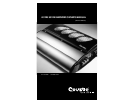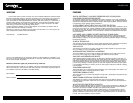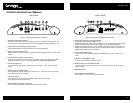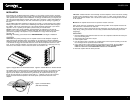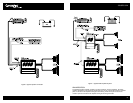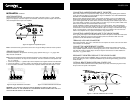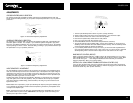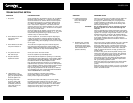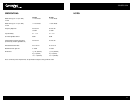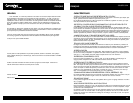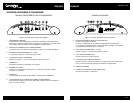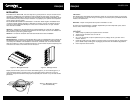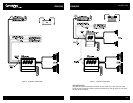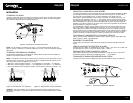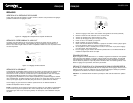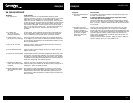
COUSTIC.COM
15
TROUBLE SHOOTING SECTION
SYMPTOM PROBABLE CAUSE
1. No power Check connections to the amplifier's Ground, B+ and Remote
terminals. Check connection at "+" terminal of the battery.
Check the remote turn-on terminal. Ensure it receives power
when the source is turned on (or when the switch is turned
on). Refer to the Installation Section. Check the power line
fuse: if fuse is blown, replace it; if fuse continues to blow,
check the power wire and also the amplifier for a short. If the
short is in the power wire, fix it; if the short is in the amplifier
itself, see your Coustic dealer.
Check the voltage at the amplifier, and the remote ON/OFF
lead. The voltage should measure between 11 V - 15 V. If the
measurement is beyond this range, have the source unit
checked out by an authorized dealer.
2. Power without sound with Turn the amplifier off, and Check all input & output signal
red power/protect cables and connections. Check the speakers for short with
indicator on a VOM (volt meter) or by connecting them to another audio
system. After making sure everything is normal, turn the ampli-
fier on again.
3. Power without sound with The continuous red light of the power indicator signals a
red power indicator on high internal operating temperature, which results in the
amplifier switching off temporarily; when the amplifier cools
down to a safe level, the amp will automatically restart.
4. Very low sound from Check your source unit’s fader control.
both radio & tape Check the amplifier's Input Sensitivity Level.
5. Frequent automatic This indicates that the amplifier is operating at a continually
amplifier shut down undesirable high internal temperature. High operating temper-
ature caused by inadequate ventilation: refer to the sub-sec-
tion titled LOCATION for better amplifier location.
High operating temperature caused by an excessively low
impedance load, say below 2 ohms: check for bad speakers
and/or electronic crossover, proper passive crossover compo-
nents; if all else fails, try rewiring the entire system.
High operating temperature can be caused by an incorrect
input sensitivity level: refer to sub-section titled INPUT SENSI-
TIVITY ADJUSTMENTS for correct setting.
6. "Motorboating": The Check the amplifier's connection to the battery.
amplifier power indicator Check battery voltage. If low, recharge or replace
going off repeatedly when battery. Check all ground connections.
the audio system is on
7. Whining noise when Reroute power cable from battery to source unit directly,
engine is running with bypassing the battery terminal in the fuse box. Check
noise varying with the power connections to be sure they areclean. Check ground
accelerator (noise level connections to be sure the ground wire is in direct contact
varies with source unit with the bare metal surface of the chassis (with that spot
volume control) scraped clean of any paint, rust or grease).
SYMPTOM PROBABLE CAUSE
8. Constant level whining Check for a ground loop in the system. Turn the system off
noise (most noise with and, one-by-one, change the ground connections (by
source unit volume at changing to a different contact point, scraping the level
minimum) constant irrespective of metal clean of any paint, rust or
grease). Turn the system on and check for whining noise
after each ground change.
CAUTION: Do not disconnect the power amplifier's ground
when the system is on. This could damage the
amplifier.
Check for defective signal cables. Disconnect signal cables
at the amplifier and listen carefully for noise. If the noise dis-
appears, run a test pair of signal cables. If there is no unde-
sirable whining noise, reconnect to the amplifier with the
new pair of signal cables. Check battery ground connection
to the vehicle chassis to make sure it is tight and clean.
Check battery negative terminal connection to make sure it
is tight and clean.
9. Radiated noise: crackling Check if the noise is actually radiated noise: tune a portable
noise on FM which is not radio to the same FM station. Move the portable radio
present when playing tape close to the vehicle engine. If crackling noise comes from
or CD (noise varying slightly the portable radio, then the noise you have in your vehicle
with accelerator but is audio system is radiated noise. Check with a VOM (volt
present at all times) meter) to makesure the antenna is really grounded to the
vehicle chassis.
To ensure a true ground, break the plastic covering of the
antenna lead and solder a piece of heavy wire (minimum
14 gauge) to the braided shield. Ground the other end of
the wire at the same point as the radio ground.
Check spark plug wires. They should be suppression-type
wire and less than 2 years old. Otherwise, replace them
with good quality suppression cables.
Make sure engine block is grounded to the vehicle chassis
at a bare metal spot (scraped clean of paint, rust and
grease).
Make sure hood is also grounded. If not, use a ground strap
(which is available from any auto parts store) to ground the
hood to the vehicle chassis.



